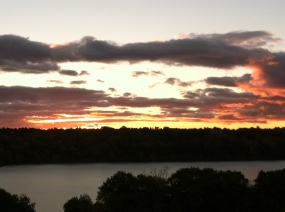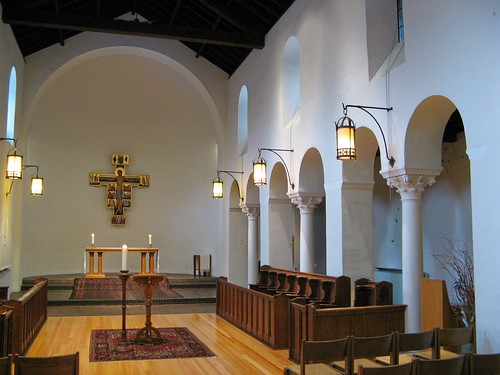I’ve spent the last month at Holy Cross Monastery, an Episcopalian monastery on the Hudson River, a few miles north and across the river from Poughkeepsie (and directly across the river from the Vanderbilt mansion). I was going to blog about my experience as I was there, but felt odd documenting my absence from my house, so I “blogged” instead in e-mails to friends, and I’ll try to condense those here, I think, but with the caveat that this simply represents one public aspect of my experience as the monastery. That doesn’t in anyway diminish or make these aspects less true, but it also doesn’t capture the fullness of my experience at the monastery here.
Usually I stay in the main guesthouse, which has about 45 rooms, give or take a few, and is open to guests from Tuesday afternoon to Sunday afternoon. In the past I’ve only managed to stay from Tuesday to Friday because weekends are often booked solid with retreat groups. However, this time I stayed a month, from June 11 to July 13th, in the newish extended stay suite, Iona, named after Iona Island, which was the home of Scottish monasticism for centuries http://www.sacredconnections.co.uk/holyland/iona.htm). My room is the Cuthbert room, named after this guy: http://en.wikipedia.org/wiki/Cuthbert
The guest rooms are monk “cells,” both in the main guesthouse and in the extended stay suite. The rooms are exactly the right size, with a twin bed and night table, comfortable reading chair, desk, bed, and sink. There is a shared bath in the suite, and a kitchenette and sitting area. The regular guest rooms are about the same, without the kitchenette and the sink in the rooms. The kitchenette is what allows guests to stay longer, so that we can feed ourselves while the monks take their very necessary Sabbath day from Sunday night through to Tuesday morning. Otherwise, all the other meals are had in the refectory where guests and monks all dine together on delicious food prepared by a Culinary Institute of America trained chef, the campus for which is just across the river as well. Here is a photograph of my room after I moved in (for the extended stay rooms, we also had closets out in the hallway – the regular stay rooms have closets/dressers right in the rooms.
The Monastery – The Guests
The monks’ main mission is running the guesthouse for whomever wants to stay, providing some of their own guided retreats, as well as hosting many retreats for groups, both church affiliated and not. While I was there several church retreats cycled through, as did a two-week stay for the Episcopal Church’s Young Adult Service Corps who were preparing a group of about thirty young adults for year-long mission projects around the world. It is sort of like the Episcopal Church’s Peace Corps, and is focused much more on community outreach projects than proselytizing. They brought a lot of good energy, and noise, to the monastery, especially before and during supper, and right after the Great Silence ended in the morning. They often seemed to escape the Great Silence by heading to swim in the Hudson in the evening, and all the monks loved having them around.
There were also many different people who came to stay on individual retreats for one to five days. Some were in the religious life (priests, deacons, nuns and such), others were simply religious (Episcopalians dominated, but other denominations as well, and other religions too, including a Buddhist priest), and many had no religious affiliation or belief at all, and were just drawn to Holy Cross as a place of respite and retreat from the world. Besides clergy, teachers seemed to be the number one occupation represented for people on individual retreats, and more than once I sat at a table full of teachers for dinner or supper.
As a guest on an independent retreat, your time is your own. Some people stay in silence for their entire visit, but most join in conversation at least during meals. While breakfast is in silence, because the monastery keeps the Great Silence from 8:30 pm to 8:30 am, with no talking during those times, during dinner, which is the noon meal, there is usually a reading for the first ten minutes or so from a text that the monks mutually agreed upon, and then there is time for open conversation. Since dinner is often people’s first meal at the monastery, I found that having the reading was a great “icebreaker,” because the reading was often good and thought provoking, and so if you are at a table of strangers, commenting on something you just heard read is always a good starting point. Even though I dread small talk, chatting around the table is rather effortless in the monastery, with so many interesting and interested people coming through the monastery, and so this introvert actually often looked forward to mealtime conversation. And when I didn’t want to chat with strangers, I would just sit in silence, and that was respected as well.
Dinner is the largest meal, with menus such as marinated flank steak, polenta and shrimp, pork loin, and so forth, and always included veggie sides and a vegetarian entrée option and gluten free offerings. Supper was always lighter fare, typically soup and salad, or sandwiches and was always open conversation. The tables are round, seating about eight (or ten?) per table, and you serve yourself your food from a buffet before seating yourself.
During the rest of the time, besides your room, there are many places to find a spot to be quiet and do writing and reading. There are spaces outside and in, in a large cloister porch that is available for conversation, and a silent cloister for prayer. There is a library room, and other small nooks and rooms here and there, and the main gathering point, and work/reading spot for most guests, is the large Pilgrim Hall, pictured below:
My favorite spot was in the corner. I don’t have a picture of me in it, but here is my friend Rebecca getting some good poetry written during her short visit with me during my monastic stay:
The Monastery – The Monks
The Order of Holy Cross has four houses, the West Park monastery, where I stayed (and is the largest) http://www.holycrossmonastery.com/ ; a priory in Toronto http://www.ohc-canada.org/ , a guesthouse in Santa Barbara http://mount-calvary.org/, and a small guesthouse and school in Grahamstown, South Africa http://www.umaria.co.za/index.html
I will do my best to explain the monastery here, but with the caveat that this is my outsiders perspective, and thus an imperfect perspective. Several of the monks blog as well, as do the Companions of Mary the Apostle, which is a new order of women that is getting its start on the grounds of the monastery, and so I recommend those blogs as well. Brother James Dowd’s blog is here: http://tendercompassionofgod.blogspot.com/ And the Companions of Mary the Apostle’s blog is here: http://companionsma.blogspot.com/
The West Park Monastery is the central house of the Order, and is the largest, with about fifteen brothers currently in residence. Their main mission, along with prayer, is the guesthouse work, and the brothers all also have jobs in relation to the monastery, like running the bookstore, or library, and they all have rotating duties in running the guesthouse, monastery and services, and they all also are active in leading retreats, spiritual direction, working in the community, and so forth, so their lives seem quite packed with meaningful work.
The main work of prayer, besides the individual prayer practices of each of the brothers, happens in the five monastic offices. Matins is at 7 am, and is the most somber of the five (in my opinion) with a recitation rather than the chanting/singing of the psalms that is done in the other offices. While I didn’t attend Matins as much at first, I grew to love how they started my day. Eucharist is at 9 am, in which Holy Communion is celebrated, and then Diurnum is at 12 pm, and is shorter, at about twenty minutes, since it is in the middle of the workday. It is also my favorite, because after a brief liturgical recitation of prayers, and a singing of a hymn, and chanting a few psalms, everyone sits in silence for about ten minutes. It is a powerful thing, to sit in silent meditation and prayer with others, especially as a practice in the middle of the day. The practice of seeking stillness in the midst of my day is a practice I intend to keep up back home, seeking out at least 10 minutes of meditation in the center of my workday. I don’t care how busy my day is, I can spare that ten minutes. Vespers is at 5 pm, and consists on the same balance of prayer, hymns, readings from scripture and more psalms.
Singing/chanting the psalms back and forth is the main practice of these offices. The monks sit facing one another, and the guests sit facing the monks, and the monks sing typically two lines of psalms, and then the other side sings the next two lines, and so forth. Guests can join in, but quietly, so that the monks can hear each other, and so the guests can hear the monks. Finally, there is Compline, which is at 8:10 pm, and when it ends, with the final blessing of the day, the Great Silence then begins. So, it is a full day of prayer, and I ended up going to more and more of these monastic offices during my stay, until I was observing the full monastic schedule, and even while doing that, my writing flourished.
The church itself is beautiful, and while I didn’t take any pictures of it, Brother Randy has some beautiful photo sets of the church interior, with one of my favorite pictures here looking toward the front of the church:
And here is a photograph looking toward the back, where the guests sit:
And here is an old picture of some of the monks (dated 2010). They where their robes during the monastic offices, and are monk casual (i.e. regular clothes) the rest of the time:
My Monastic Writing Life
After Matins, I ate breakfast, and then wrote from 8 to 12, with a break for Eucharist in the last few weeks, and then stop and attend Diurnum and then dinner. After dinner, I sometimes wrote a bit more, depending on how the day was going, but I also generally headed out for a hike by around 2 or 3 pm. I’d shower upon returning, then read, attend Vespers, eat Supper, read, attend Compline and then read some more. I think I will post a separate post with a brief description of my various hikes. I read seventeen books in my month at the monastery, all of which fed my writing in some way. In order to write, I NEED to refill the well, and I need to refill it with poetry, fiction and non-fiction. When I’m in the midst of writing a brand new story, I get skittish about reading fiction, but as soon as I’m in the revising stage, I love to read fiction. And poetry I can read any time, and need to read all of the time, especially in the morning.
I imagine that this should maybe be the longest part of the post, since this took up most of my time there, but this was also inward directed work, so there is little I can write about it. I will, however, share a couple of poems that really spoke to me while I was there, and you can likewise use the link on the side of this page to visit my Goodreads page from the link on the left side of my blog.
I read the poem, “Autumn Inaugural,” by Dana Gioia in his beautiful book, Pity the Beautiful, (click on link for my Goodreads review) and resonated so much in the traditions of the monastery, of how the old traditions seek through symbolism toward a connection that transcends the merely rational:
I.
Like a desert saint, fed only on faith,
As if the still star of painted plaster
They are always more or less than what
What native speech do we share but imperfection?
II.
Old robes worn for new beginnings,
Or a newborn washed with water and oil.
And dream of a future so fitting and so just
It didn’t say we had to be morbid.The Book said the beloved died,
But also that she comes again,
That he’s reborn as words.The Book said: Everything perishes.
The Book said: That’s why we sing. (6)










Pingback: Monk Camp #2 – Into the Great Silence | The Great Ramble